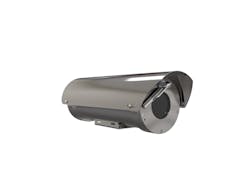The Big Bang Theory: Explosion-Proof Cameras
Analog used to dominate the video surveillance field in hazardous environments; however, technology advances are helping to blow that field wide open. Specifically, new explosion-protected network camera technology is kick-starting a major shift from analog to IP-based video in these markets — similar to the migration experienced in other video surveillance applications.
Containing an Explosive Situation
Explosion-protected or explosion-proof network cameras are encased in heavy-duty, stainless steel enclosures certified for hazardous environments. The housings contain any explosions originating within the enclosures, stopping any sparks from escaping and igniting vapors, gases, dust, and/or fibers in the surrounding air.
Explosion-protected cameras adhere to the three basic design principles required for equipment placed in hazardous environments: prevention, segregation and containment. In regards to prevention, the electrical and thermal energy is limited to safe levels, both during normal operation and if a fault should occur. In regards to segregation, the electrical parts or hot surfaces are physically separated from the explosive atmosphere either by pressurization or encapsulation. For containment, if an explosion should occur, the housing confines it to a well-defined area, preventing it from propagating to the surrounding atmosphere.
To meet the criteria of “explosion-protected,” these network cameras must conform to specific industry standards and certification, which differ around the world. In the U.S. and Canada, for example, the applicable standards are issued by Underwriters Laboratories (UL) and the Canadian Standards Association (CSA). The suitability of equipment for specific hazardous areas in the ANSI/NFPA(NEC) regulated market (the U.S. and Canada) must be tested by a Nationally Recognized Testing Laboratory (NRTL) institute, such as UL or FM. Evaluation can also be performed by accredited laboratories, such as LabTest Certification (LC) that approves according to applicable CSA and UL standards.
Because explosion-protected network cameras must be certified according to the applicable industry standards of the country in which it is to be used, integrators and end-users can be sure that they have undergone rigorous testing to ensure health, safety and the environment.
Enhanced Features and Target Markets
It is important to note that explosion-protected network cameras are not one-trick ponies. In addition to explosion containment, the cameras provide superior image quality compared to their analog predecessors. Network cameras not only deliver intelligent image processing and excellent streaming performance, but are also based on open standards that allow them to seamlessly integrate with other security and safety systems on the premises. These features are familiar to any integrator who has pitched an analog-to-IP conversion.
Specific to industrial control systems, an explosion-protected network camera gives eyes to the sensors, which can significantly shorten the time service personnel need to be inside hazardous areas and the downtime of the machinery. The cameras can be used to improve overall safety and security by monitoring the entire plant and transportation system, from the perimeter to the critical center.
There are a vast number of industry segments where hyper-vigilance is crucial and therefore explosion-protected network cameras are particularly well suited, such as oil and gas refineries, offshore platform rigs, gas pipelines and distribution centers, gas stations and chemical processing plants. Other, perhaps less obvious industry segments include printing, paper and textile industries, sugar refineries, grain handling and storage facilities, woodworking areas, waste treatment and premises used for metal surface grinding – especially aluminum dusts and particles. Even though the materials used in these segments usually are considered to be non-flammable, or slow burning, they may be ignited and explode when in dust form.
Needs of the Oil and Gas Industry
Apart from the risk of explosions in hazardous areas, the oil and gas industry must regularly collect critical data from remote well sites, offshore drilling platforms and outlying production locations, as well as from Supervisory Control and Data Acquisition (SCADA) systems set up to monitor facilities, such as storage tanks, pumping stations or pipelines. Some well sites are miles away from the closest monitoring facilities, making on-site data collection a costly and time-consuming operation. Establishing the required broadband network links between multiple locations can be extremely difficult. Given that these activities generally occur where wire line links are not practical, network video surveillance systems can provide a welcome alternative.
Using the explosion-protected network cameras for real-time remote monitoring and control enables users to revise operations in distant facilities on the fly in response to changing system demands. Hardened network video surveillance systems can be used for monitoring critical zones and processes, such as drilling, pumping, compressor stations, tanks, pipelines and refineries. They can also supply company personnel with the high-speed video connections that they require.
Despite the issues with remote facilities and the challenges they bring, the main concern of oil and gas companies must be health, security and the environment. Here, too, network cameras can have a positive impact on compliance. With network video surveillance in place, operators can verify that safety instructions and environment policies are being upheld and that personnel are using the right tools and protective equipment. In addition, network video surveillance systems can reduce risk levels by monitoring emergency procedures and crowd flows.
Benefits of Network Cameras in Hazardous Environments
Analog video systems fall short when it comes to functionality in hazardous environments. Not only do network cameras deliver superior image quality, built-in video analytics, increased safety, and easy future-proof installation and integration, they also provide remote accessibility, better scalability and flexibility and lower total cost of ownership.
Image quality: Network cameras provide full HDTV-resolution with exceptional image quality and color fidelity at a high frame rate. Motorized optical zoom and autofocus features allow the cameras to cover great distances providing both wide overviews and detailed images for identification purposes. Images from a network camera are digitized once and they stay digital without any unnecessary conversions or image degradation due to distance traveled over a network. In an analog system, images have to be converted several times on their way from the camera to the operator. Furthermore, the excellent light sensitivity of network cameras makes them able to record scenes in high detail even in low-light conditions, without any extra illumination equipment. With Wide Dynamic Range (WDR) technology the cameras can easily handle the span of dark shadows and bright sunlight within the same frame of view without losing details at either end of the spectrum.
Video analytics and increased safety: As with other markets, built-in intelligence such as Video Motion Detection, Cross Line Detection or Active Tampering Alarm are vitally impotant in hazardous environments to enable constant analysis to detect an event and automatically respond to it with actions such as video recording and alarm notifications. Other intelligent features include Pixel Counter, which assures that the pixel resolution of an object fulfills any regulatory or specific customer requirements for identification purposes, and Advanced Gatekeeper, which automatically moves the camera to a preset position when motion is detected in a predefined area.
Flexible integration: Network video provides a high level of integration with other equipment and functions. Existing computer networks, such as Local Area Networks (LAN) and the Internet, can be used for video streaming and video storage. Unlike an analog system, a fully integrated network video system can be used for a multitude of applications simultaneously, such as access control, building management, fire alarms and intruder and visitor management. Especially applicable to hazardous industrial environments, equipment temperatures can be remotely monitored simply by adding a temperature alarm camera to a system of network cameras.
Scalability: In a network video system, any number of network video products can be added without significant and costly changes to the network infrastructure. Video encoders make it possible to integrate an existing analog Closed-circuit Television (CCTV) video system with a network video system, taking advantage of existing cameras and infrastructure and combining them with the benefits of state-of-the-art network camera technology.
Remote accessibility: In a network video surveillance system, users can access real-time and archived video at any time, from any authorized computer anywhere in the world. Network cameras can be used for both remote monitoring and to facilitate remote maintenance. The cameras can provide managers with an initial, visual inspection in lieu of sending a technician to the site. When hands-on maintenance is required, service personnel working in a hazardous area could be monitored remotely as a safety precaution.
E. Anthony Incorvati is the North American Business Development Manager for Critical Infrastructure and Transportation for Axis Communications. To request more info about Axis, visit www.securityinfowatch.com/10212966.
About the Author

Anthony Incorvati
Anthony Incorvati leads the Transportation market segments for Axis Communications in the Americas, overseeing business strategy, opportunity development, technology planning, marketing input, and ecosystem and end-user engagement & development. His focus spans Aviation, Rail, Maritime, Public Transport, ITS/Traffic, and Cargo & Logistics. Since joining Axis in 2010, Anthony has brought over 20 years of transportation industry experience, including leadership roles at NAVAIR (U.S. Department of the Navy), SAE International, Marconi Communications/Ericsson, and Bombardier Transportation.
He represents Axis on key industry committees within APTA, AAPA, ACI-NA, and ACC, and chairs the SIA Transportation Working Group. Anthony holds a B.S. in Industrial Engineering from The Pennsylvania State University.
